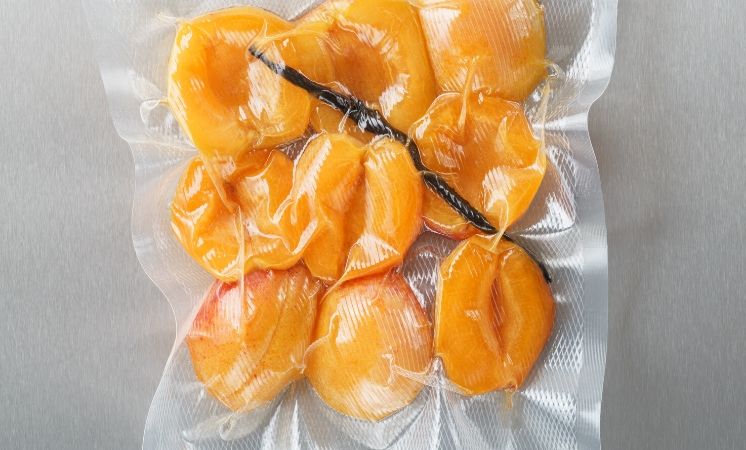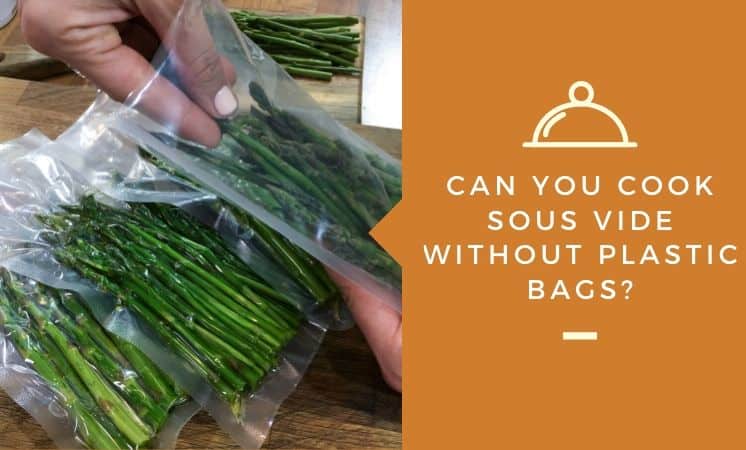One of the first images that comes up when you think of or search up images of the term, “sous vide” is food that is sealed tightly shut in plastic of some kind and submerged in a water bath.
While this is certainly one way to keep the food from touching or mixing with the water, sous vide is not about cooking with plastic or plastic being a must-use item during the cooking process.
The only reason that cooking sous vide is synonymous with the use of plastic is because the original chefs chose to use vacuum-sealed plastic as a means of keeping the food separate from the water. Rather, the cooking technique is more about heating the food up at a stable temperature.
So, can you cook sous vide without plastic?
You can cook sous vide-style without placing the ingredients in vacuum-sealed bags. Using plastic bags is the more common approach as it keeps the water from mixing with the ingredients and, essentially, reducing the taste. Canning jars are a good substitute for plastic bags when cooking sous vide. Some items, such as eggs, can even be cooked without a container.
Some chefs choose to use Pyrex casserole dishes as the vessel while others simply use glass containers.
The only criteria that makes sous vide, sous vide is that the food must be cooked underwater with precise temperature.
Choosing to cook with glass is a great way to relieve any anxiety surrounding the use of plastic, however, we will run through some common safety questions that come up around the use of sealing food, using plastic baggies, and what you should buy if you want to cook sous vide with or without plastic.
Does Sous Vide Need to Be Vacuum-Sealed?
While sous vide does mean “under vacuum” in French, you do not need to purchase an expensive or inexpensive vacuum sealer to successfully cook your food at low temperatures in a water bath.
If you are new to sous vide or have a budget that you need to stick too, you can simply use regular Ziploc-style bags.
If you want to purchase high-grade bags that are intended to be sealed with a vacuum sealer but cannot get your hands on a vacuum sealer, you can still use these to cook in sous vide without sealing them.
How Do You Use a Bag Without Sealing It?
If you are using a Ziploc-style bag but cannot seal it, simply remove as much air as possible before placing it in the water bath. To do this, follow the steps below.
⦁ Make sure that your sous vide device is filled with the water bath.
⦁ Place your food ingredients inside the bag, making sure that they do not come up past 1 inch or 2.5 centimeters from the bag opening and close the zipper almost all of the way shut.
⦁ There will be a tiny bit of air at the top of the bag, but it will get displaced by the water when you place the bag into your sous vide machine.
⦁ Submerge the bag slowly into the water, leaving the top portion of the bag where the zipper is exposed.
⦁ The water should come up to just below where you can zip it up.
⦁ Zip the bag shut.
You do not have to worry about there being too much air in the bag as the temperature at which you cook your food will prevent any bacteria growth.
Is It Safe To Sous Vide in Ziploc Bags?
When it comes to using plastic, we are told that items like plastic bottles, plastic plates, and take out containers can all leach bad chemicals into our foods.
So, of course, many of us no longer use these types of items as we do not want to consume harmful chemicals. This has brought on a lot of concern for individuals who want to cook in sous vide using plastic bags like Ziploc.
However, current research indicates that when you use food-grade, high-density polyethylene, polypropylene, or low-density polyethylene bags, you are generally safe.
For those who are looking to purchase sous vide bags specifically, almost all sous vide plastic bags are made from these plastics and their inner linings are almost always polyethylene.
Other types of plastics, such as bulk plastic wraps that are made out of polyvinyl chloride, polyvinylidene chloride or polycarbonate as these do contain harmful plasticizers that can leach into fattier foods like cheese or high-fat cuts of meat.

If you are planning on using plastic bags with your sous vide machine, do not use any that are made out of these types of plastic, as they will leach chemicals into your food when heated.
While using Ziploc bags for sous vide is considered generally safe, there will always be some small health risk involved in cooking food in plastic. The best way to minimize any risk is to use high-quality bags and engaging in safe cooking techniques and methods that reduce risk.
Choose Ziploc bags that are made out of low-density polyethylene and if you are cooking in water temperatures that are above 158 degrees Fahrenheit, double bag your Ziploc bags.
This prevents the bags from coming open at the seams and exposing your food to water.
Are Ziploc Bags BPA free?
Yes, almost all name brand Ziploc bags are BPA free. This means that they are not made out of bad plastics such as polycarbonate, which releases the chemical Bisphenol A (BPA).
Generally, it is plastic cling wrap, plastic bottles, or very cheap plastic plates, utensils, and containers that are not BPA free and will leach BPA into your food when you heat them.
What Type of Plastic Bags to Use For Sous Vide?
⦁ Ziploc-Style Bags.
These types of bags are really good to use if you do not plan on buying a vacuum sealer and like to cook a lot of meats such as chicken breasts, burgers, pork chops, fish, and steak.
If you want to cook several servings of food inside the same bag, look out for the galleon sized ones. Always purchase Ziploc style bags that are made from high-quality plastics.
If cooking above 158 degrees Fahrenheit or 70 degrees Celsius, double bag your Ziploc bags.
⦁ Sous Vide Bags.
These types of bags are some of the best to use because they are designed for higher temperatures, have strong and long seams, and are vacuum-sealable (although not necessary).
They are also great if you want to clip the bag to the side of your pot or secure it with the lid as these bags tend to be much larger than Ziploc-style.
These are very good for cooking braised meats, beans, vegetables, and lentils.
- Avoid using plastic wrap.
While you can buy high-quality plastic wrap, they are generally not very good for wrapping your food and cooking it.
What it is good for is to use as a wrap around the outside of your sous vide machine to help cut down on water evaporation during longer cook times.
What to Use If Not Cooking with Plastic?
If you do not want to use sous vide bags or Ziploc-style bags, you can use canning jars. While these are traditionally used for canning and pickling food, they are very easy to come by and are made out of glass, so they can be reused.
Canning jars are great for sous vide cooking if you are planning on doing “batch-cooking” where the recipe needs to set, like with yogurts and custards. However, there are some things you will need to keep in mind if you choose to use canning jars.
⦁ Do not tighten the lids all the way, as air will need to escape during the cooking process.
⦁ Your jars can float.
⦁ Be careful of getting burned when you remove the jars. Glass jars contain thermal mass and will stay heated for much longer than a bag would.
⦁ Glass is an insulator, so it will require more time to cook with them than if you were using plastic bags. If you choose to cook meat from the freezer or refrigerator, it’s going to take much longer than if it were at room temperature.
⦁ Heat takes longer to pass through glass, so your canning jars will act more like an oven. To help the heat reach the food, consider using liquid sauces.
⦁ Pay attention to your liquid levels, some can oxidize if your liquid levels aren’t right.
⦁ The temperature of the air that is above the waterline will affect the cooking process. Try to keep the air around the same temperature as the water as this reduces how much energy gets wasted.
Other than this, always make sure that your jars are sterile. Do not store your sous vide food unrefrigerated and on a shelf as the sous vide temperature is much lower than traditional canning temperatures.
Refrigerating if you are not going to eat the food right away is a must for safety reasons.

